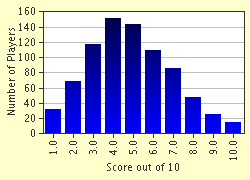Quiz Answer Key and Fun Facts
1. What would be the name of the interval from middle C to the A-Sharp above middle C?
2. The scale D - E - F - G - A - B-flat - C# - D would be known as which of the following?
3. When resolving one 7th chord to another, it is often necessary to leave out one of the chord tones of the second 7th chord in order to avoid harmful parallels. Which of the chord tones in one of these incomplete seventh chord is most commonly omitted?
4. In a first inversion diatonic major or minor triad in a four-voice texture, which chord member should be doubled? (Choose the best answer!)
5. Which of the following chords would be the EXPECTED resolution of an EMm7 chord?
6. In which voice would a 2-3 suspension most likely occur?
7. The Seven Part Rondo is expressed as having the makeup A-B-A-C-A-B-A. Often, the composer will omit one of the parts, leaving it with only 6 parts (the last movement of Beethoven's 5th Piano Concerto is an example). Which part then is most often omitted?
8. What interval is the inversion of a Major 6th?
9. How many different types of diatonic 7th chords are available in the Major mode?
10. How many types of diatonic triads are available in the Major mode?
Source: Author
bmrsnr
This quiz was reviewed by FunTrivia editor
ralzzz before going online.
Any errors found in FunTrivia content are routinely corrected through our feedback system.

